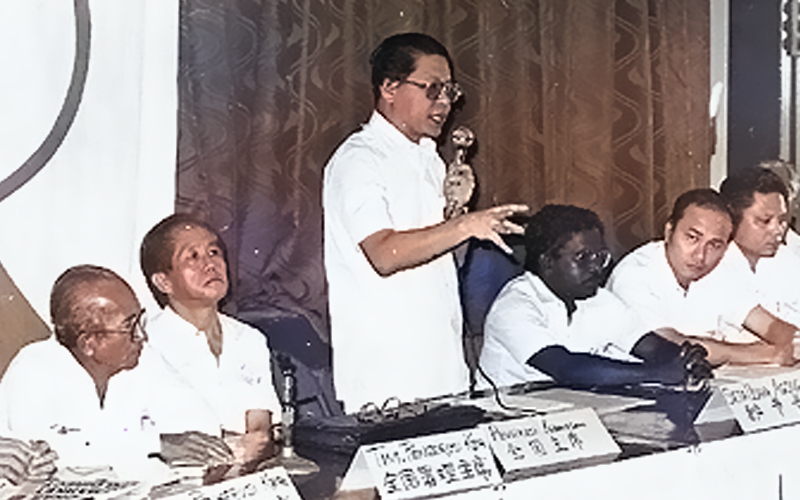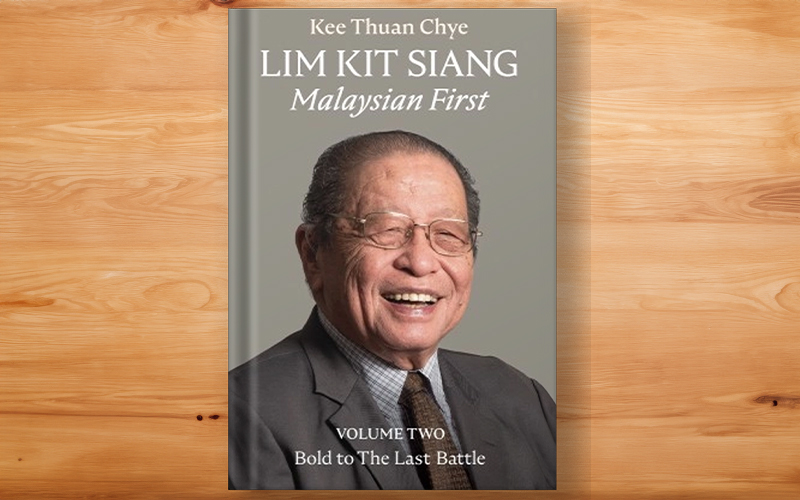FMT:
When ‘Robocop’ crushed Kit Siang’s dream of winning Penang
DAP failed in three attempts to win power in Penang. After a disastrous outing at the 1995 general election, the plan was abandoned.

Posters of DAP veteran Lim Kit Siang touting him as the next chief minister were put up all over Penang in the run up to the “Tanjung 2” battle. (File pic)
PETALING JAYA: When DAP strongman Lim Kit Siang moved from Melaka to contest a seat in Penang in 1986, the party announced that it was making Penang a frontline state in its attempt to win power and form a government.
It was obvious that Kit Siang was the frontrunner for the chief minister’s post in the event of an election victory. Billing its campaign as the “Battle of Tanjung”, the party made major inroads and won 10 of the 33 seats in the assembly.
According to the newly-published second volume of his biography “Lim Kit Siang – Malaysian First” by author Kee Thuan Chye, the DAP was buoyed by its success and made a serious bid to take over the Penang state government at the next general election in 1990.
For that campaign, dubbed Tanjung 2, the party formed an alliance with the Umno splinter party Semangat 46, formed by Umno strongman Tengku Razaleigh Hamzah after a major falling-out with party president and then prime minister Dr Mahathir Mohamad.
“DAP leaders were gung-ho about winning the state especially after the opposition coalesced into a united force with Semangat 46 which also established a separate pact with PAS and other Muslim parties to form a combined front,” party leaders said of the impending clash. Both pacts were headed by Razaleigh
In view of this, posters were put up all over the state, touting Kit Siang for chief minister.
“That was the ultimate goal. That’s what we had been dreaming of for years. And we thought 1990 was the best time as Kit Siang was 49 and the Barisan Nasional chief minister for 21 years, Lim Chong Eu, was 71,” said former Penang DAP strongman and strategist Gooi Hock Seng.

To show its seriousness, DAP sent out a strong signal by pitting its top state leaders against BN kingpins in six tough seats in a calculated move to try and form the government.
To lead by example, Kit Siang did the unthinkable by going against Chong Eu in Padang Kota, the state seat in the heart of George Town where Chong Eu had been returned for four terms.
Not only that, Kit Siang was armed with a letter signed by Razaleigh, addressed to the Penang governor, saying his Gagasan Rakyat coalition was nominating the DAP leader for the chief minister’s post.
“However, the DAP managed to win only 14 seats which was four more than the 1986 polls, although Kit Siang defeated Chong Eu comfortably. But none of its allies won any and thus it failed to form the government again. It needed 17 seats to be in power,” said a leader.
“We expected Semangat 46 to win four or five seats but unfortunately the Malays pulled their hand brakes at the last minute. It was a case of so near yet so far.”
Undeterred, DAP declared Tanjung 3, its battle to capture Penang at the 1995 general election, despite the booming economy.
Party strategists decided to portray Kit Siang as a “Robocop” who would clean up Penang, using the character from a popular science fiction movie, of an android – a human with steel and electronics parts – who heartlessly crushes all lawbreakers with super-human strength and abilities.
It was a disaster. Penang voters humiliated the DAP by returning only one assemblyman from the party.
Kit Siang was soundly defeated in Tanjung Bungah where he had gone to challenge Gerakan chief Koh Tsu Koon, who had replaced Chong Eu as the chief minister in 1990.
Another former Gerakan leader, Chia Kwang Chye, attributed DAP’s fall to its Robocop strategy, which he said was seen by people as a childish and arrogant effort.
“The DAP was trying to create the impression of a very strong character fighting against a weak character. It was kind of arrogant. The arrogance was not acceptable to the people. I would also like to say that as this was his third time contesting in Penang, the aura of Kit Siang may have subsided.”
But some other leaders attributed DAP’s huge loss to the booming economy and Mahathir lifting a ban on visits to China.
Seputeh MP Teresa Kok said many Chinese were happy that Malaysians could travel freely to China after Chinese voters had gone against the government in the 1990 general election.
“A lot of Chinese business people were very happy. Many were also able to go and see their relatives there and visit their ancestors’ graves. Many people were happy and thanked Mahathir,” she said.
After the Robocop flop, Kit Siang did not pursue his dream of becoming chief minister or capturing Penang at the 1999 elections, which were also disastrous for him and DAP.
He lost in the Kebun Bunga state seat and the Bukit Bendera parliamentary constituency, and moved to Ipoh Timur in Perak for the 2004 and 2008 elections, before ending up in Johor for the 2013 and 2018 general elections.
PETALING JAYA: When DAP strongman Lim Kit Siang moved from Melaka to contest a seat in Penang in 1986, the party announced that it was making Penang a frontline state in its attempt to win power and form a government.
It was obvious that Kit Siang was the frontrunner for the chief minister’s post in the event of an election victory. Billing its campaign as the “Battle of Tanjung”, the party made major inroads and won 10 of the 33 seats in the assembly.
According to the newly-published second volume of his biography “Lim Kit Siang – Malaysian First” by author Kee Thuan Chye, the DAP was buoyed by its success and made a serious bid to take over the Penang state government at the next general election in 1990.
For that campaign, dubbed Tanjung 2, the party formed an alliance with the Umno splinter party Semangat 46, formed by Umno strongman Tengku Razaleigh Hamzah after a major falling-out with party president and then prime minister Dr Mahathir Mohamad.
“DAP leaders were gung-ho about winning the state especially after the opposition coalesced into a united force with Semangat 46 which also established a separate pact with PAS and other Muslim parties to form a combined front,” party leaders said of the impending clash. Both pacts were headed by Razaleigh
In view of this, posters were put up all over the state, touting Kit Siang for chief minister.
“That was the ultimate goal. That’s what we had been dreaming of for years. And we thought 1990 was the best time as Kit Siang was 49 and the Barisan Nasional chief minister for 21 years, Lim Chong Eu, was 71,” said former Penang DAP strongman and strategist Gooi Hock Seng.

To show its seriousness, DAP sent out a strong signal by pitting its top state leaders against BN kingpins in six tough seats in a calculated move to try and form the government.
To lead by example, Kit Siang did the unthinkable by going against Chong Eu in Padang Kota, the state seat in the heart of George Town where Chong Eu had been returned for four terms.
Not only that, Kit Siang was armed with a letter signed by Razaleigh, addressed to the Penang governor, saying his Gagasan Rakyat coalition was nominating the DAP leader for the chief minister’s post.
“However, the DAP managed to win only 14 seats which was four more than the 1986 polls, although Kit Siang defeated Chong Eu comfortably. But none of its allies won any and thus it failed to form the government again. It needed 17 seats to be in power,” said a leader.
“We expected Semangat 46 to win four or five seats but unfortunately the Malays pulled their hand brakes at the last minute. It was a case of so near yet so far.”
Undeterred, DAP declared Tanjung 3, its battle to capture Penang at the 1995 general election, despite the booming economy.
Party strategists decided to portray Kit Siang as a “Robocop” who would clean up Penang, using the character from a popular science fiction movie, of an android – a human with steel and electronics parts – who heartlessly crushes all lawbreakers with super-human strength and abilities.
It was a disaster. Penang voters humiliated the DAP by returning only one assemblyman from the party.
Kit Siang was soundly defeated in Tanjung Bungah where he had gone to challenge Gerakan chief Koh Tsu Koon, who had replaced Chong Eu as the chief minister in 1990.
Another former Gerakan leader, Chia Kwang Chye, attributed DAP’s fall to its Robocop strategy, which he said was seen by people as a childish and arrogant effort.
“The DAP was trying to create the impression of a very strong character fighting against a weak character. It was kind of arrogant. The arrogance was not acceptable to the people. I would also like to say that as this was his third time contesting in Penang, the aura of Kit Siang may have subsided.”
But some other leaders attributed DAP’s huge loss to the booming economy and Mahathir lifting a ban on visits to China.
Seputeh MP Teresa Kok said many Chinese were happy that Malaysians could travel freely to China after Chinese voters had gone against the government in the 1990 general election.
“A lot of Chinese business people were very happy. Many were also able to go and see their relatives there and visit their ancestors’ graves. Many people were happy and thanked Mahathir,” she said.
After the Robocop flop, Kit Siang did not pursue his dream of becoming chief minister or capturing Penang at the 1999 elections, which were also disastrous for him and DAP.
He lost in the Kebun Bunga state seat and the Bukit Bendera parliamentary constituency, and moved to Ipoh Timur in Perak for the 2004 and 2008 elections, before ending up in Johor for the 2013 and 2018 general elections.
***
kt comments:
Penang was eventually LOST by Gerakan; DAP never did win it by themselves. By then, Penangites were sorely disappointed with Koh Tsu Koon for his lack of political courage, which ironically DAP is today guilty of.
Prior to 2008 Lim KS was then my hero but I lost my admiration for him after he allied with you-know-who. T'was then I grew disenchanted with his power-crazed ambitions. He even became KHAT, so lost was he to his own party principles!
After Lim Chong EU lost his seat and retired, and Koh Tsu Koon replaced him, UMNO basically took over all the actual main decisions in Penang, with Gerakan in name only.
ReplyDeletePenang lapsed into a corrupt torpor until 2008
Fortunately, for all Chow Kon Yeow's lethargy, DAP has not deteriorated into such depths in Penang.
At a national level, things remain very difficult. DAP remains tarred by decades of successful UMNO Demonisation of DAP as anti-Malay, anti-Islam and anti-Monarchy. The campaign Now picked up by Perikatan Nasional.